Fujifilm X-Pro1 Review
Fujifilm X-Pro1 Introduction
The Fuji X-Pro1 is the first Fuji SLD and it aims directly at the high-end market with its unique 16 megapixels X-Trans CMOS sensor and very mechanical retro design. It uses an 1.5X crop sensor with a 3:2 aspect ratio, just like the majority of DSLRs, except that forgoes an anti-alias filter thanks to its unique color-filter-array which is not prone to Moire artifacts.
With this camera, Fuji introduced its own XF lens mount which has a very short flange distance. This makes it easier to design high-quality lenses and lens-mount adaptors, including one made by Fuji for the Leica M-mount. Fuji launched this camera with three bright prime lenses, rather than the usual zooms, reinforcing the X-Pro1 as a high-end offering with a small footprint. This is crucial for SLDs since they must provide a clear advantage over DSLRs which have an iron-grip on the high-end digital camera market.
The Fuji X-Pro1 features a unique Hybrid-Viewfinder, perfected from the Finepix X100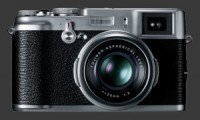
Fujifilm Finepix X100, which can switch between a 1.5 MP high-resolution EVF and a rangefinder-style OVF. It also has a super-sharp 1.2 MP 3" LCD. There are mechanical dials for shutter-speed and EC plus a control-dial on the camera and an aperture-ring on all current XF-mount lenses. This gives it the direct and efficient controls favored by photographers. All this in a durable metal body with hot-shoe for external lighting.
This digital camera review analyses the usability, performance and image quality of the Fuji X-Pro1.
Fuji X-Pro1 Features
Sensor
- 16 Megapixels CMOS sensor
- X-Trans Color-filter array
- No Anti-Alias filter
- 1.5X Crop factor (APS-C)
- 3:2 Aspect ratio
- Fuji XF lens mount
- Built-in Dust-Reduction
Exposure
- ISO 200 to 6400 sensitivity range, 1/3 EV steps
- ISO 100, 12800 and 25600 expansion, JPEG only
- Auto ISO, Selectable maximum from 400 to 3200
- ISO Bracketing, 3 frames, 1/3, 2/3 or 1 EV steps
- 1/4000-30s Shutter-speeds, 1/3 EV steps
- Bulb exposure, maximum 1 hour
- PASM Exposure modes
- Multi-Segment, Spot and Average metering
- Exposure-Compensation, ±2, 1/3 EV increments
- Auto-Exposure Bracketing, 3 frames, 1/3, 2/3 or 1 EV increments
- Automatic and selectable Dynamic-Range, 100%, 200% or 400%
- Dynamic-Range Bracketing, 3 frames
- Flash-Compensation, ±2/3 or 1/3 EV increments
- Auto, Forced, Slow-Sync, Rear-Sync and Off Flash modes
Image Parameters
- Automatic, 8 presetsSunny, Shade, Cloudy, 3 Fluorescents, Incandescent, Underwater, Kelvin and Custom WB
- WB fine-tuning along 2 axis in 19 steps
- Film Simulation: Provia, Velvia, Astia, Pro Negative Hi, Pro Negative Standard, B&W plus 3 optional filters, Sepia
- Film Simulation Bracketing, 3 frames
- Noise reduction, 5 levels
- Optional Long-Shutter noise reduction
- Adjustable Color, Sharpness, Highlight Tone, Shadow Tone, 5 steps each
Focus
- Single-shot or Continuous autofocus
- Manual-focus (MF), Electronic Magnification
- Automatic or Manual focus-point selection
- 49-areaOnly 25 areas when susing OVF AF system
- Optional AF-Assist lamp
- Fly-By-Wire focus ring on lenses
Drive
- 6 FPS Continuous Drive
- 20 JPEG or 12 RAW Buffer
- Multiple-Exposure, 2 frames
- Self-timer, 2s or 10s
Video
- 1920x1080 @ 24 FPS Video
- 1280x720 @ 24 FPS Video
- MPEG-4 codec
- Stereo sound
Display & Viewfinder
- Hybrid EVF/OVF:
- 0.47" EVF, 1.4 Megapixels, 100% coverage
- 0.37 / 0.6X Dual-Magnification OVF, 90% coverage lines, Over 100% view
- 3" LCD, 1.2 Megapixels
- Digital Level, 1-axis
- Depth-Of-Field Preview
- Optional Live-Histogram
- Optional Framing-Guides, 3 types
Output Processing
- 3:2 Native aspect ratio
- 16:9 and 1:1 cropped aspect ratios
- 16, 8 and 4 megapixels modes
- JPEG, RAW, RAW+JPEG capture
- 2 JPEG Compression levels
Misc
- Customizable AE-L / AF-L button
- Customizable Function (Fn) button
- Full-stop shutter-speed dial
- Aperture ring on lenses
- Third-Stop EC dial
- One adjustment-dial
- Standard Hot-Shoe
- HDMI (1080i) output
- USB 2.0 connectivity
- SDXC memory
- Lithium-Ion battery
- Add-on flash supplied
Fujifilm X-Pro1 Suitability - What is it good for?
The Fuji X-Pro1 features a 16 megapixels sensor with a unique color-filter array which does not require an anti-alias filter. Normally, an anti-alias filter is placed right in front of the sensor to very slightly blur light reaching the sensor. This avoids the sensor trying to resolve details which are too fine and could result in Moire artifacts. The side-effect of this is that most camera sensors never get as much details as they can capture, assuming a high quality lens, of course. Incidentally this has been a selling point for cameras using Foveon sensors as well as the Nikon D800E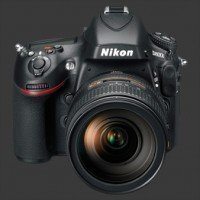
Nikon D800E DSLR which is the no-anti-alias-filter version of the D800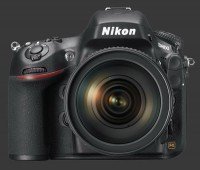
Nikon D800.
Having such a high-resolution sensor without an anti-alias filter makes the X-Pro1 suitable for large prints with extremely sharp details, as long as the lens in use is sufficiently sharp. This is probably why Fuji started the XF-mount with high-quality prime lenses. Otherwise, they might have wiped out the resolution advantage of the new X-Trans technology.
The sensor in this Fuji is as large as is currently found in Sony SLDs and in the Pentax K-01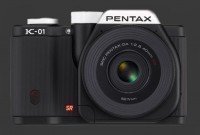
Pentax K-01 which gives it good resistance to image noise. With a standard ISO range reaching 6400, the Fuji X-Pro1 can work in very low-light. Those shooting JPEG images also have access to expanded sensitivities up to 25600 and ISO 100.
This digital camera is built in a tough metal body with plenty of external controls including direct dials for shutter-speed, exposure-compensation and aperture (on the lens) for efficient access. Despite the high-end build, the X-Pro1 is not weather-sealed and neither are any current XF-mount lens. This makes it suitable for professional use but not in adverse weather conditions.
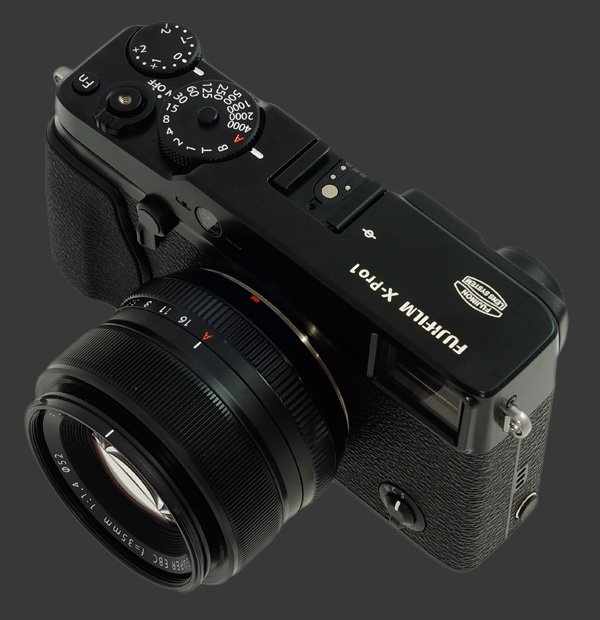
This SLD is equipped with the most sophisticated viewfinder system yet which lets users choose the behavior according to their preferences. This hybrid viewfinder provides a fully electronic view in the form of a 0.47" EVF with 1.4 megapixels. In this mode shows a sharp and detailed view of the scene with exactly 100% coverage. Sadly, this view is not Exposure-Priority, negating the most fundamental advantage of EVFs over OVFs. The optional Live-Histogram is of no help either since it is based on the display brightness.
The hybrid viewfinder also provides an optical mode with electronic overlay. This is based on the technology of the Fujifilm Finepix X100
Fujifilm Finepix X100 except with two levels of magnification, depending on the lens in use. In OVF mode this is officially a Reverse Galilean viewfinder. Similarly to an optical tunnel, it sees through its own window above the lens. This gives it a slightly different viewpoint than the camera and does not preview focus, exposure or white-balance. The viewfinder coverage is actually much greater than 100% but it depends on the attached lens. Fuji added an electronic overlay or HUD to show additional information. Most importantly, there is an overlaid frame which shows the 90% coverage area. Anything within that area hopefully makes it into the captured image.
Street photographers who must act very quickly to capture fleeting moments are advantaged by the OVF mode since they can watch the periphery of the frame, paying attention to elements as they enter the 90% coverage area. Because there is a separate optical path for the OVF, there is no blackout time whatsoever which greatly helps following a subject. On the other hand, this mode makes it impossible to precisely compose and results in images which must nearly always be cropped later on. The EVF mode provides the 100% coverage needed for precise framing but blacks out when the shutter is released and lags behind action, just like all current EVF cameras. The beauty here is that the Fuji X-Pro1 offers the choice.
A full complement of manual controls, including manual focus, choice of metering modes and custom white-balance gives photographers complete control over the creative process with the X-Pro1. There is also a RAW mode for those who with to process their images differently than the camera. This shortens the buffer-depth for 6 FPS continuous shooting from 20 to 12 which is still sufficient to catpure the height of action with up to 2s of anticipation.
All this to say that the Fuji X-Pro1 is suitable with most types of photography within the limitations of lenses at hand, which we discuss in the next section of this review. The lack of weather-sealing seems a curious choice by Fuji but should also be considered when deciding if the X-Pro1 fits your needs.
Fujifilm X-Pro1 Fuji XF Mount & Lenses
There are currently only 3 lenses made for the Fuji XF-mount. Those are Fuji's own 18, 35 and 60mm lenses. Considering the APS-C sensor-size of the X-Pro1, these are roughly equivalent to 28, 50 and 90mm lenses on a film or full-frame camera. These are highly used focal-length but having only three to choose from is the most limiting factor of this camera.
All Fujinon XF-mount lenses share a similar design with a metal body and very smooth finish. The build quality is excellent yet they feel surprisingly light for their size. Each lens has its own aperture ring with an A position to let the camera automatically choose the aperture. There are very soft detents on the aperture-ring, so it is very easy to accidentally change settings. This happens constantly while mounting and unmounting the lens. Maybe future lenses will improve this but we are unlikely to see a fix for the current ones.
All current XF-mount lenses have a fly-by-wire focusing ring with a fine texture to prevent slipping. The same fine texture is unfortunately prone to holding on to particles and is difficult to clean. The focus ring itself turns super smoothly but it looks like the camera adjusts focus in small discreet steps. There is quite a bit of throw to focus from up-close to infinity, which helps with precise focusing. Focusing quickly for street photography is less than ideal though.
Fujinon XF 18mm F/2R
The Fujinon XF 18mm F/2R is a wide-angle lens with a bright maximum aperture. With an equivalent focal-length of 27mm, this is known as a moderate wide-angle and is normally used for shooting in relatively tight spaces without the strong perspective distortion of ultra-wide lenses. This is most often used for journalistic-style street photography where the photographer interacts closely with his subjects. The XF 18mm F/2R comes with a metal bayonet hood and two lens caps, one standard center-pinch lens cap and one rectangular rubber cap to cover the hood. While the plastic cap holds well, the rubber one falls often and feels really cheap.
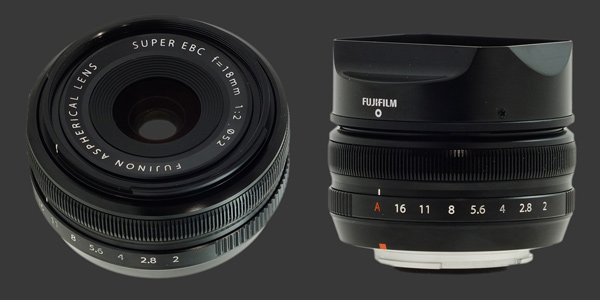
This Fujinon lens is fairly sharp except at its maximum F/2 aperture. There is strong corner softness which turns into very mild softness at F/2.8. The center though start sharp and becomes very sharp at F/2.8 and stays that way until F/11 the diffraction limit is reached. Distortion is relatively high but Fuji hides it well by always applying distortion correction in-camera for JPEG images and in their converter for RAW data. Third-Party RAW software show the full extent of distortion.
Vignetting is mild but easily noticeable against uniform backgrounds at all apertures. It is only a little more pronounced at F/2 but never goes down below 0.5 EV. There is more vignetting when using third-party RAW conversion than in JPEG from the X-Pro1. Strangely, the difference is rather small, less than 0.1 EV while vignetting is extremely easy to correct in software.
Fujinon XF 35mm F/1.4R
The Fujinon XF 35mm F/1.4R is an ultra-bright normal lens. With an equivalent focal-length around 50mm, this lens gives a very natural perspective. It is commonly used to isolate nearby subjects, particularly since its F/1.4 maximum aperture can blur out backgrounds completely. Like the XF 18mm, this one also comes with a metal bayonet lens hood and two lens caps.
This lens uses 7 rounded aperture-blades to produce smooth bokeh in out-of-focus areas. The R designation on all these lenses means that the diaphragm blades have the radius finely adjusted to ensure the opening is close to a true circle at all aperture settings and the XF 35mm F/1.4R takes fully advantage of this.
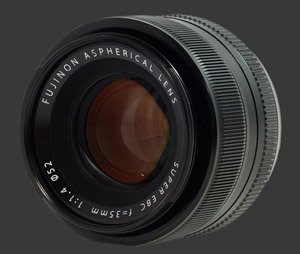
This lens achieves excellent sharpness throughout the frame at F/4 and beyond, until F/11 when diffraction hits. At F/5.6 is becomes even sharper but only measurably so. Opening up to F/2.8 introduces very slight blurring at the extreme corners which is completely usable. At F/2 and wider, corner blurring is strong and shows up a little further from the corners of the frame. Vignetting is slightly noticeable at F/1.4 and becomes unnoticeable from F/2.8. Distortion is very low too. Overall, this is an excellent lens and probably an essential one.
Fujinon XF 60mm F/2.4R Macro
The Fujinon XF 60mm F/2.4R is portrait lens with a 1:2X magnification ratio. With an equivalent focal-length of 90mm and a minimum focus distance of 27cm, this lens is ideal for portraits. It gives a flattering perspective and can blur backgrounds nicely thanks to its F/2.4 maximum aperture. Fuji designatied this a Macro lens and it is definitely more macro than the other two but is not a Macro lens in the strict sense of the term which require a 1:1 magnification ratio or, if measuring in full-frame equivalent, at least a 2:3 ratio.
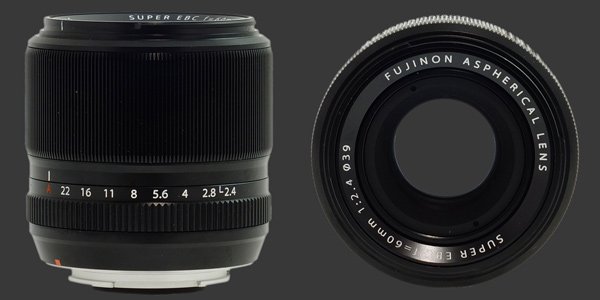
This is the highest quality lens in the Fuji XF lineup. It shows an exceptional performance by being completely sharp edge-to-edge starting at its maximum F/2.4 aperture. Distortion is slight and nearly completely corrected by the X-Pro1 and Fuji's RAW converter. Vignetting is only noticeable at F/2.4 and drops below 1/4 EV which is insignificant for most subjects at F/3.2. Simply an excellent lens.
More XF Lenses
Yesterday, Fuji revealed road map showing two more lenses coming this year, an ultra-wide 14mm F/2.8 and, the first XF-mount zoom, a stabilized 18-55mm F/2.8-4 OIS. Five more lenses are also scheduled to appear in 2013, including a 23mm F/1.4 and 27mm F/2.8 pancake early in the year. We can expected more native lenses form the usual third-parties eventually as well.
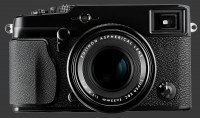 |
Please Support Neocamera
All information on Neocamera is provided free of charge yet running this website is a huge endeavor. Purchases made via affiliate links found throughout the site help keep it running and up-to-date. There is no additional cost to you, so please consider buying via these links to our affilates:
Thank you for your support!
Fujifilm X-Pro1 Highlights

Sensor-Size: 24 x 16mm

Actual size when viewed at 100 DPI
| 16 Megapixels Mirrorless | ISO 100-25600 |
| Fujifilm X Mount 1.5X FLM | Shutter 1/4000-30s |
| 0.47" Hybrid EVF 1.4 Megapixels (0.60X) | Full manual controls, including Manual Focus |
| Automatic Eye-Start sensor | Custom white-balance with 2 axis fine-tuning |
| 1 Axis Digital Level | Spot-Metering |
| Built-in Dust Reduction | Hot-Shoe |
| 6 FPS Drive, 20 Images | Lithium-Ion Battery |
| 1920x1080 @ 24 FPS Video Recording | Secure Digital Extended Capacity |
| 3" LCD 1.2 Megapixels |
Updates
2025.11.13

Best Gifts for Photographers in 2025 by Budget
The annual Neocamera Photography Gift Guide updated to 2025. Find great gifts for photographers with any price budget.
2025.07.07

Stellar Photo Recovery Review
Review of Stellar Photo Recovery V12. This Windows and MacOS software can recover photos and videos in a huge number of formats from memory cards, USB drives, SSDs and HHDs.
2025.05.14

Huion Kamvas 13 Gen 3 Review
In-Depth review of the Huion Kamvas 13 Gen 3 Pen Display Tablet for photographers and graphic artists.
2025.01.18

Fujifilm GFX 2025 Lens Roundup
Lens Review roundup of Fujifilm GFX Medium-Format lenses. Quality, performance and handling of the GF20-35mm F/4R WR, GF30mm F/3.5 Tilt-Shift and the GF55mm F/1.7.
2024.11.18

Best 2024 Photography Gifts for Every Budget
Great gifts for photographers and photo enthusiasts selected for every budget among the best products of 2024.
2024.08.07

Eye Protection Tips for Professional Photographers
The four main considerations for professional photographers regarding eyewear.
2024.07.14

Fujifilm X100VI Review
Flagship fixed-lens compact digital camera with a 40 MP sensor and Image-Stabilization, a first for the series. Retro design featuring dual control-dials, plus direct ISO, Shutter-Speed and EC dials. Its hybrid viewfinder can switch between EVF and OVF mode.
2024.05.09

Fujifilm GFX100 II Review
Flagship 102 Megapixels Medium-Format Mirrorless Digital Camera with 8-Stop 5-Axis IBIS, 8 FPS Drive, 8K Video and 400 MP Super-Resolution capture in a weatherproof and freezeproof body with dual control-dials and dual memory-card slots.
2024.04.03

Fujifilm X-T5 Review
Newest Fujifilm flagship boasting a 40 MP APS-C sensor, 5-axis IBIS with 7-stop efficiency, 15 FPS continuous drive, 6.2K Video capture, dual control-dials and dual SDXC UHS-II slots in a sturdy weatherproof and freezeproof body.
2023.11.20

Best Digital Cameras of 2023
Find out which are the Best Digital Cameras of 2023. All the new Mirrorless Digital Cameras from entry-level to high-end professional.
2023.07.10

Fujifilm X-H2 Review
40 Megapixels APS-C Hybrid Mirrorless Digital Camera with 7-stop IBIS. Fastest shutter ever and 8K video capture. Large builtin EVF with 0.8X magnification and 5.8 MP, plus an Eye-Start Sensor. Packed with features and large number of controls in a weatherproof and freezeproof body.
2023.05.07

Sony FE 20-70mm F/4G Review
Review of the unique Sony FE 20-70mm F/4G lens. The optical zoom of this lens spans ultra-wide-angle and medium focal-length coverage, making it one of the most versatile Full-Frame lenses on the market.












